Chinese Name: 中国紫檀博物馆 Pronunciation: Zhōngguó Zĭtán Bówùguăn
Suggested Visiting Hours: 2-3 Hours
Occupied Area: 25,000 square meters
Address: No. 23, Jianguo Road, Chaoyang District, Beijing, China
Building Function: The museum was built to display red sandalwood arts and traditional Chinese furniture.
| Tourists | Ticket Price |
| Adults | 50 yuan |
| Seniors (60-64 years old) |
20 yuan |
1. Children under 1.2 meters or under 6 years old.
2. Seniors aged 65 and above are free of charge.
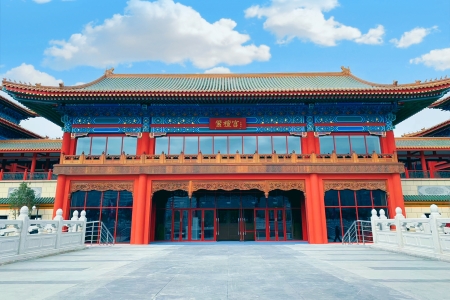
China Red Sandalwood Museum was invested by Ms. Chan Laiwa, a member of the Chinese People’s Political Consultative Conference (CPPCC) and Chairwoman of Hong Kong Fuwah International Group. It is China’s first and largest private museum that is specialized in the collection, display, and research of red sandalwood arts and classical Chinese furniture.
The museum itself is a spectacular work of art. It is a building complex with the architectural style of the Ming and Qing Dynasties(1368-1912). It is magnificent and exquisite in design, blending ancient and modern architectural characteristics. Its main gate is of a purely wooden structure that used more than 400 cubic meters of wood. It is rare in Beijing’s pseudo-classic buildings in both aspects of scale and material.
The museum has an exhibition area of 9,569 square meters. It is equipped with a central hall, a display hall, a VIP hall, a multifunctional hall, and other halls. It also houses furniture in the Ming and Qing Dynasties, Buddhist cultural artworks, and various carving crafts.
Besides, models of quadrangle courtyards and ancient buildings are on display, such as the corner tower at the Palace Museum, the Hall of Prayer for Good Harvest of the Temple of Heaven, and the Feiyun Tower. All of the models are made of precious red sandalwood, reflecting the artistic charm of Chinese culture.
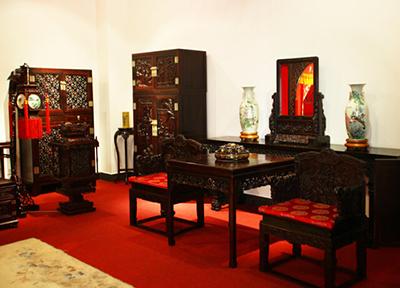
The museum has been adhering to the philosophy of “inheritance, development, and innovation” and working hard to promote traditional Chinese furniture arts for many years. It is devoted to protecting and innovating the red sandalwood carving techniques, which are on the verge of extinction.
To spread traditional Chinese red sandalwood culture overseas, the museum has successively held exhibitions with the theme of “The Mystery of Red Sandalwood” in the United States, Japan, South Korea, and other countries. Those exhibitions introduce China to the world and display Chinese classical furniture culture. Moreover, the furniture culture has attained high praise from local people.
In the future, China Red Sandalwood Museum will continue to carry forward the traditional Chinese culture, show the charm of red sandalwood arts, and reproduce the brilliance of traditional Chinese furniture!
On September 19, 1999, China Red Sandalwood Museum held an opening ceremony, with more than 1,200 distinguished guests from all walks of life.
From December 2000 to March 2001, some exhibits in the museum were shown in the “Exhibition of Chinese Royal Antique” held by the Ministry of Culture of the People’s Republic of China in Seoul, South Korea.
In 2001, the museum held inauguration ceremonies for the golden plaque of the Red Sandalwood Palace, the “Tian Yuan” (Round Sky) Pavilion, and the “Di Fang” (Square Earth) Pavilion.
In 2003, the museum was rated as a national 4A tourist attraction by the National Tourism Administration, receiving foreign leaders and tourists from all over the world.
In 2005, the museum held a red sandalwood artwork handover ceremony, donating four red sandalwood artworks to world-famous museums.
In 2011, the “Red Sandalwood Sculpture” proposed by the museum was selected in the third batch of national intangible cultural heritage by the State Council of China.
In 2012, the museum was selected by the Beijing Municipal Bureau of Culture as the Beijing Municipal Production and Protection Model Base of Intangible Cultural Heritage.
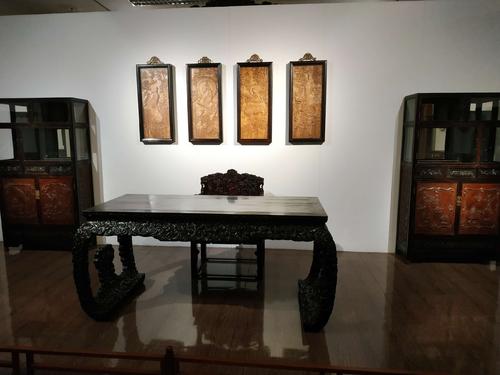
The table is made of Huanghuali wood and owns two parts: a tabletop and four legs. The tabletop is a rectangular board with a waist, and the legs are circular columns. The connecting rod in front of the table is engraved with cloud patterns and two phoenixes flying toward the sun. The rods on the sides of the table boast patterns of flowers and birds.
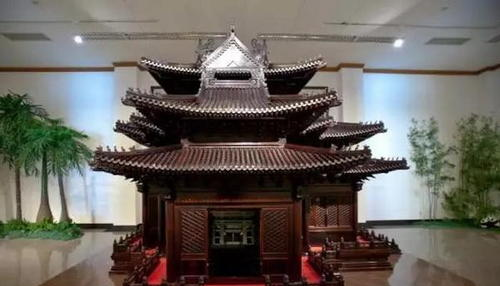
The corner tower at the Palace Museum is featured by three-layer eaves, six gable-and-hip roofs, and seventy-two ridges. It has a complicated structure and is a wonderful artwork in ancient Chinese buildings. The model of the corner tower is made of red sandalwood. It is carved exquisitely and meticulously, reproducing the style of the corner tower.
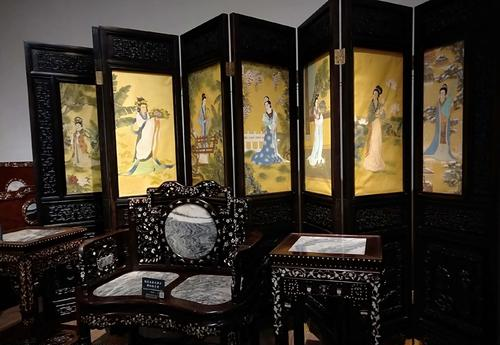
The screen is made of red sandalwood. It is composed of five panels, with the middle one being the tallest. The middle of the cap of the screen is engraved with the patterns of bats. The two sides of the screen are piercingly engraved with the patterns of the Chinese Kui Dragon. Each panel is divided into three parts by four rods. The upper part is embossed with the patterns of bats, chime stone, and curly grass, and the middle part is deeply engraved with the patterns of figures and landscape.
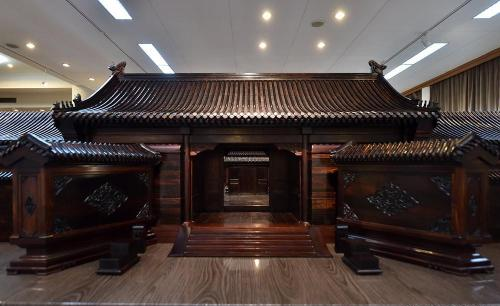
The model is made of red sandalwood on the whole. It takes the quadrangle dwelling with three courtyards as the prototype and was built with a scale of 1 to 5. The quadrangle dwelling (Siheyuan) is a kind of traditional residence in northern China and enjoys a long history. The model of the quadrangle dwelling is well-made and perfectly reproduces the major features of ancient Chinese buildings.
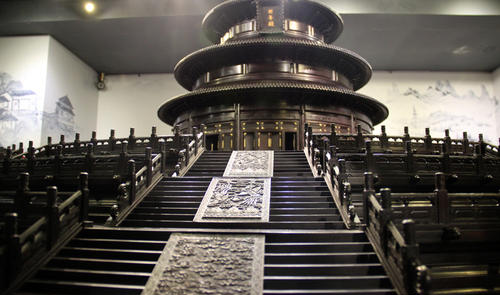
The model, made of red sandalwood, is the replication of the Hall of Prayer for Good Harvest with a scale of 1 to 10. It was made with exquisite craftsmanship and meticulous work. The Hall of Prayer for Good Harvest is the main building of the Temple of Heaven where the emperors of the Ming and Qing Dynasties prayed for the good harvest of a year.
The hall was built based on the concept of “Tian Yuan (Round Sky)”. It stands on a three-story round platform and has a triple-eave circular roof. It is a classic ancient Chinese building with a wooden structure.
1. Smoking is strictly prohibited in the museum.
2. Please do not talk loudly, cross the fence, or touch the exhibits.
3. Please put your bags, drinks, and other belongings in the electronic automatic lockers.
4. Photographing is only allowed in the six photo spots where the description boards are marked with camera logos.
5. Visitors who are disheveled or bring pets are forbidden to enter.
6. The Red Sandalwood Palace is the sole tourist area, and other areas are not open to visitors.
Take bus 517 or Shuttle 141 and get off at Gaobeidianqiao Bei Station. After getting off, you need to walk southward about 50 meters along the Xinglongjie(Xinglong St.), turn right, walk about 30 meters, turn front-left, walk about 50 meters, turn right into the Jianguolu(Jianguo Road), walk about 260 meters to the destination.
Take bus 468 or 553 and get off at Xinglong Jiayuan Nanqu Station. After getting off, you need a 7-minute walking. Walk southward about 130 meters along the Gaobeidian Beilu(Gaobeidian North Road), turn left to walk 10 meters into Jianguolu(Jianguo Road), walk about 320 meters to the destination.a
Take Metro Line 1 and get off at Sihuidong Station (Exit A). After that, you need to walk eastward about 110 meters, turn front-right, walk about 20 meters, turn left into Jianguolu(Jianguo Road), walk about 830 meters, turn left, walk about 50 meters to the destination.
Take Metro Ba Tong Line and get off at Gaobeidian Station (Exit A1). After that, you need to walk westward about 390 meters along the Jianguolu(Jianguo Road) to the destination.
Chinese: 请带我去中国紫檀博物馆。 English: Please take me to China Red Sandalwood Museum.
If you go to China Red Sandalwood Museum from the center of Beijing (Grand Hyatt Beijing), it takes about 20 minutes (about 30 yuan).
If you go to China Red Sandalwood Museum from Beijing Capital International Airport, it takes about 25 minutes (about 80 yuan).
If you go to China Red Sandalwood Museum from Beijing Daxing International Airport, it takes about 50 minutes (about 200 yuan).
If you go to China Red Sandalwood Museum from Beijing West Train Station, it takes about 40 minutes (about 80 yuan).
